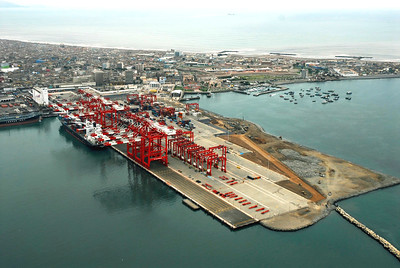Great Power Tango: Unraveling Peru’s Strategic Dance
Joseph Brennan
Associate Editor
Last April, Italian energy firm Enel sold its Peruvian power grid to the China Southern Power Grid International, according to the Financial Times. The power grid was sold for $2.9 billion and powers the northern part of Lima, Peru’s capital, and much of the northern half of the country. Other electrical supply grids across the country were previously owned by a separate Chinese electrical firm, the Three Gorges Corporation, which also owns the largest hydroelectric dam in Peru. In October 2019, China Yangtze Power International acquired Peru’s largest electric company for $3.6 billion, reports NS Energy. This integration demonstrates how the relationship between Peru and China has been rapidly evolving in recent years, particularly in terms of economic cooperation. China’s increasing interest in South American countries like Peru should be raising concerns and sparking debates, showing a need for the United States to re-examine its role in the region.
China has become an essential trade and investment partner for Peru, solidifying its foothold in the country’s economy, and its involvement in Peru extends beyond its acquisition of electrical companies. The two countries have fostered a strategic partnership, primarily driven by economic cooperation and infrastructure development. Global Americans writes that Peru has been a beneficiary of China’s Belt and Road Initiative (BRI), a massive infrastructure project aimed at connecting Asia with Europe and Africa, since 2019.
Through the BRI, China has invested heavily in Peru’s transportation and energy sectors, contributing to the country’s development. China’s investments in Peru’s transportation infrastructure have been transformative. The development of roads, railways, and ports has not only enhanced domestic connectivity but has also positioned Peru as a crucial node in China’s broader vision of global economic integration. This has facilitated more effective trade routes within Peru, allowing Peruvian goods to reach international markets more efficiently on land. Peru’s strategic location has thus become pivotal in China’s endeavor to create a comprehensive network linking the Pacific and Atlantic Oceans, allowing Chinese goods to be moved from ports in Peru through the Panama Canal faster than before, writes the South China Morning Post.
The deepening economic ties with China have brought both benefits and challenges for Peru. Since joining the BRI, Peru has become a member of both the Asian Infrastructure Investment Bank and Asia-Pacific Economic Cooperation (APEC), furthers Global Americans. On one hand, Chinese investments have provided much-needed capital, technology, and expertise to develop critical infrastructure projects. These projects include rebuilding roads in the Lima region or establishing irrigation systems in the La Libertad region, which the International Trade Administration reports is going to cost $28.5 billion. This has helped Peru improve its infrastructure, stimulate economic growth, and create employment opportunities.
Additionally, China has become an important export market for Peruvian commodities, such as copper ore, iron ore, and animal products. However, challenges arise due to the potential risks associated with heavy reliance on Chinese investments. Critics argue that China’s economic influence could lead to a debt trap, as seen in other countries participating in the BRI, reports The Wall Street Journal. This debt trap occurs when China loans money to developing countries for infrastructure projects that they most likely cannot pay back. This has led some countries like Sri Lanka to sell off crucial state assets to the Chinese government or affiliates to pay back the loans, according to NBC News.
Peru, which is in a precarious economic position faces similar risks. In September 2023, with the support of the BRI, Peru began the construction of a new $3 billion port for a Pacific trade route to China, furthers the South China Morning Post. Moreover, concerns have been raised about the environmental impact of Chinese-led projects, such as unsafe mining procedures, and the social consequences of increased Chinese economic presence in Peru, as seen in the immediate aftermath of the ousting of former president of Peru, Pedro Castillo.
While China’s growing influence in Peru and South America cannot be overlooked, it is crucial for the United States to maintain economic cooperation and investments in the region. Historically, the United States has been a key player in South American affairs, and it is in its strategic interest to reinforce its engagement, both economically and politically. South America presents immense economic opportunities for the United States. The region is rich in natural resources, such as oil, gas, minerals, and agricultural products. By fostering stronger economic ties, the United States can tap into these resources, create jobs domestically, and bolster its own economic growth.
Additionally, increased U.S. investment in South America would provide an alternative to Chinese dominance and promote a more balanced economic landscape. From a geopolitical perspective, the U.S.’s presence in South America acts as a counterbalance to China’s expanding influence. By strengthening economic cooperation, the United States can offer an alternative to Chinese investments, thereby preventing excessive dependence on a single global actor and deterring Chinese economic coercion in the region. This not only safeguards the region’s autonomy but also promotes a more balanced distribution of economic power.
Political stability and security in South America are crucial for regional and global stability. The United States has a vested interest in ensuring the promotion of democratic governance, human rights, and the rule of law in the region. By prioritizing engagement with South American countries, the United States can support and strengthen democratic institutions, promote good governance, and contribute to regional stability. This, in turn, would have a positive impact on U.S. security interests particularly relating to the migration of asylum seekers in Latin America to the United States.
The United States should adopt a proactive approach to counter Chinese influence in South America. This can be achieved through increased economic and diplomatic engagement, as well as the promotion of transparent and sustainable development practices. The creation of these practices could include developing programs to help Peruvian law enforcement combat the spread of illicit narcotics trafficking, records the U.S. State Department. Economically, the United States Agency for International Development (USAID) has invested $137 million into the development of Peru’s private sector.
The House of Representatives Foreign Affairs Committee, however, reports that since 2019 China has invested $10.4 billion into Peru’s private sector. Despite the United States and Peru’s long and diplomatic history, China is making inroads by building goodwill in the country through its investments. It is imperative that the U.S. increase investment in Peru to counter China’s continuous efforts to build hegemonic superiority in the region. By offering viable alternatives to Chinese investments, the United States can safeguard its interests and foster mutually beneficial partnerships with South American countries. Peru’s interests should lie in further developing a stronger economic partnership with the United States because, unlike China, the U.S. has an interest in preserving its free market and liberal democracy.
In terms of exports and imports, the United States should become further involved with Peru. The U.S. imported $7.39 billion of Peruvian goods, second only to the $17.7 billion of Peruvian goods that China received in 2021, according to the Observatory of Economic Complexity (OEC). The OEC further reports that China exports more goods to Peru than the U.S. does, $14.3 billion and $9.7 billion, respectively. The United States has for too long not approached Peru with the urgency it warrants and ignored China’s rise in Latin America. Recognizing this gap underscores the importance of reevaluating trade policies, negotiating favorable terms, and exploring new avenues for collaboration.
By fostering a more balanced trade relationship, the U.S. can contribute to the economic development of both nations. The U.S. should leverage its diplomatic history to build a renewed and dynamic partnership with Peru. Strengthening people-to-people ties, fostering cultural exchanges, and promoting educational initiatives can further solidify the foundation of the bilateral relationship. Part of this lax approach to the continuance of a robust economic and diplomatic relationship with Peru is due to the longevity of U.S. influence in the region. The United States has held diplomatic relations with Peru since 1826 but did not establish an official embassy there until 1920.
However, there has been a Chinese presence in Peru since the mid-1800s. From the 1840s to 1880s, Chinese indentured servants arrived in Peru after slaves had been emancipated in 1854. These servants and laborers helped to build up the Peruvian economy by building railroads and harvesting crops. In 2009, Peru and China signed the China-Peru Free Trade Agreement, the first of its kind in Latin America. China has since been Peru’s largest trade partner. Furthermore, in 2013, China promoted its relationship with Peru to a “comprehensive strategic partnership,” which the Council on Foreign Relations highlights is “the highest classification [China] awards to its diplomatic allies.” The promotion of Peru to this prestigious status underscores the depth and significance of the bilateral relationship, extending beyond mere economic collaboration to encompass a comprehensive and strategic partnership that spans various domains of mutual interest.
Peru’s dynamic relationship with China is deeply intertwined with the demographic composition and historical ties between the two nations. Another notable facet shaping this connection is the substantial presence of Chinese-Peruvians within the country, a demographic reality that carries historical and cultural significance. The numerical prominence of Chinese-Peruvians in comparison to their American counterparts within Peru serves as a unique factor that influences the diplomatic and economic relations between Peru and China. This demographic reality, highlighted by The Diplomat, underscores the socio-cultural fabric that binds the two nations. A shared history, traditions, and familial connections create a foundation upon which diplomatic and economic partnerships can flourish.
From a strategic perspective, China’s recognition and acknowledgment of the Chinese-Peruvian community can be seen as a diplomatic advantage. It provides China with a natural point of connection and familiarity with Peru, fostering a sense of trust and understanding. This foundation, rooted in shared identity, has facilitated the rapid development of the relationship between the two countries. Moreover, the presence of a significant Chinese-Peruvian population may also influence public opinion and societal attitudes towards China. Cultural exchanges and shared experiences can serve as a catalyst for positive perceptions, potentially mitigating challenges that can arise in international relations.
United States economic cooperation with Peru has yielded numerous benefits, fostering increased trade and a diversified export portfolio. The U.S. serves as a significant market for Peruvian exports, ranging from minerals and textiles to agricultural products. Moreover, collaboration with American companies has facilitated technological transfer, particularly in sectors like telecommunications, contributing to economic development and innovation. Additionally, U.S. investment in Peru may lead to infrastructure development projects, enhancing the overall business environment. This partnership not only strengthens economic ties but also promotes cultural exchange, fostering better understanding and diplomatic relations.
Comparatively, South Korea has experienced substantial advantages from its economic collaboration with the United States. Specifically in the high-tech sector, especially in areas like semiconductors and electronics, South Korea has turned from working with China to working with the United States which has seen significant advancements through joint efforts. Mutual investment flows and research and development initiatives have played a crucial role in the economic growth of both countries, creating job opportunities, and fostering innovation. The collaboration extends beyond the economic realm, encompassing cultural exchanges in fields such as entertainment and education. Both Peru and South Korea exemplify how strong economic partnerships with the United States can lead to trade expansion, technological development, and enhanced cultural ties, highlighting the multifaceted nature of such cooperation.
Image courtesy of Flickr



